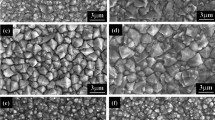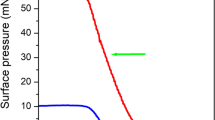Abstract
The impact of 1-decanethiol self-assembled monolayer (SAM) formation and removal cycles on polycrystalline Au surfaces and SAM quality was studied with the help of CV, DPV, Pb-UPD, STM, and AFM. The SAM removal was accomplished by dissolution with oxygen radicals generated by UV photolysis of aqueous hydrogen peroxide. During the first Au-SAM formation and removal cycles, the surface roughness decreased. After that, the surface properties remained almost unaffected, indicating that the cyclic treatment removed the most reactive gold surface sites, until a rather stable surface resulted, which guaranteed highly reproducible SAM formation.






Similar content being viewed by others
References
Ulman A (1996) Formation and structure of self-assembled monolayers. Chem Rev 96(4):1533–1554. https://doi.org/10.1021/cr9502357
Laibinis PE, Whitesides GM (1992) Self-assembled monolayers of n-alkanethiols on copper are barrier films that protect the metal oxidation by air. Am Chem Soc 114(23):9022–9028. https://doi.org/10.1021/ja00049a038
Häkkinen HJ (2012) The gold–sulfur interface at the nanoscale. Nat Chem 4(6):443–455. https://doi.org/10.1038/nchem.1352
Azzam W, Al-Momani L (2013) A new striped-phase of decanethiol self-assembled monolayers on Au(111) formed at a high solution temperature. Appl Surf Sci 266:239–244. https://doi.org/10.1016/j.apsusc.2012.11.162
Poirier GE, Pylantt ED (1996) The self-assembly mechanism of alkanethiols on Au (111). Science 272(5265):1145–1148. https://doi.org/10.1126/science.272.5265.1145
Camillone N, Leung TYB, Schwartz P, Eisenberger P, Scoles G (1996) Chain length dependence of the striped phases of alkanethiol monolayers self-assembled on Au(111): an atomic beam diffraction study. Langmuir 12(11):2737–2746. https://doi.org/10.1021/la951097j
Uehara TM, De Aguiar HB, Bergamaski K, Miranda PB, De Sa U (2014) Adsorption of alkylthiol self-assembled monolayers on gold and the effect of substrate roughness: a comparative study using scanning tunneling microscopy, cyclic voltammetry, second-harmonic generation, and sum-frequency generation. J Phys Chem C 118(35):20374–20382. https://doi.org/10.1021/jp5054919
Hoogvliet JC, Dijksma M, Kamp B, van Bennekom WP (2000) Electrochemical pretreatment of polycrystalline gold electrodes to produce a reproducible surface roughness for self-assembly: a study in phosphate buffer pH 7.4. Anal Chem 72(9):2016–2021. https://doi.org/10.1021/ac991215y
Tkac J, Davis JJ (2008) An optimized electrode pre-treatment for SAM formation on polycrystalline gold. J Electroanal Chem 621(1):117–120. https://doi.org/10.1016/j.jelechem.2008.04.010
Poirier GE (1997) Mechanism of formation of Au vacancy islands in alkanethiol monolayers on Au (111). Langmuir 10:2019–2026
Wilbur, James; Whitesides GM (1999) Self-assembly and self-assembled monolayers in micro- and nanofabrication. In: Nanotechnology. Springer Science and Business Media New York, New York
Scholz F, López de Lara González G, Machado de Carvalho L, Hilgemann M, Brainina KZ, Kahlert H, Jack RS, Minh DT (2007) Indirect electrochemical sensing of radicals and radical scavengers in biological matrices. Angew Chem Int Ed Engl 46(42):8079–8081. https://doi.org/10.1002/anie.200702690
Hilgemann M, Scholz F, Kahlert H, de Carvalho LM, da Rosa MB, Lindequist U, Wurster M, do Nascimento PC, Bohrer D (2010) Electrochemical assay to quantify the hydroxyl radical scavenging activity of medicinal plant extracts. Electroanalysis 22(4):406–412. https://doi.org/10.1002/elan.200900385
Hamelin A, Katayama A, Picq G, Vennereau P (1980) Surface characterization by underpotential deposition: lead on gold surfaces. J Electroanal Chem 113(2):293–300. https://doi.org/10.1016/S0022-0728(80)80030-1
Hamelin A (1979) Lead adsorption on gold single crystal stepped surfaces. J Electroanal Chem 101(2):285–290. https://doi.org/10.1016/S0022-0728(79)80242-9
Nowicka AM, Hasse U, Hermes M, Scholz F (2010) Hydroxyl radicals attack metallic gold. Angew Chem Int Ed Engl 49(6):1061–1063. https://doi.org/10.1002/anie.200906358
Hasse U, Fricke K, Dias D, Sievers G, Wulff H, Scholz F (2012) Grain boundary corrosion of the surface of annealed thin layers of gold by OH· radicals. J Solid State Electrochem 16(7):2383–2389. https://doi.org/10.1007/s10008-012-1756-x
Jacob JDC, Lee TR, Baldelli S (2014) In situ vibrational study of the reductive desorption of alkanethiol monolayers on gold by sum frequency generation spectroscopy. J Phys Chem C 118(50):29126–29134. https://doi.org/10.1021/jp504463z
Wano H, Uosaki K (2005) In situ dynamic monitoring of electrochemical oxidative adsorption and reductive desorption processes of a self-assembled monolayer of hexanethiol on a Au(111) surface in KOH ethanol solution by scanning tunneling microscopy. Langmuir 21(9):4024–4033. https://doi.org/10.1021/la050209w
Shepherd JL, Kell A, Chung E, Sinclar CW, Workentin MS, Bizzotto D (2004) Selective reductive desorption of a SAM-coated gold electrode revealed using fluorescence microscopy. J Am Chem Soc 126(26):8329–8335. https://doi.org/10.1021/ja0494095
Canaria CA, So J, Maloney JR, Yu CJ, Smith JO, Roukes ML, Fraser SE, Lansford R (2006) Formation and removal of alkylthiolate self-assembled monolayers on gold in aqueous solutions. Lab Chip 6(2):289–295. https://doi.org/10.1039/b510661c
Jouikov V, Simonet J (2015) Cathodic carboxylation of gold in thick {Au-CO2}n layers. A model for reversible electrochemical sequestration of CO2. Electrochem Commun 59:40–42. https://doi.org/10.1016/j.elecom.2015.06.020
Lee LYS, Lennox RB (2007) Electrochemical desorption of n-alkylthiol SAMs on polycrystalline gold: studies using a ferrocenylalkylthiol probe. Langmuir 23(1):292–296. https://doi.org/10.1021/la061684c
Funding
The work was funded by the German Research Foundation (Deutsche Forschungsgemeinschaft, DFG) as part of the research training group (RTG) 1947.
Author information
Authors and Affiliations
Corresponding author
Electronic supplementary material
ESM 1
(GIF 31 kb)
Rights and permissions
About this article
Cite this article
Thal, D., Kahlert, H., Chinnaya, J. et al. Impact of gold-1-decanethiol-SAM formation and removal cycles on the surface properties of polycrystalline gold and SAM quality. J Solid State Electrochem 22, 1149–1154 (2018). https://doi.org/10.1007/s10008-017-3858-y
Received:
Revised:
Accepted:
Published:
Issue Date:
DOI: https://doi.org/10.1007/s10008-017-3858-y




